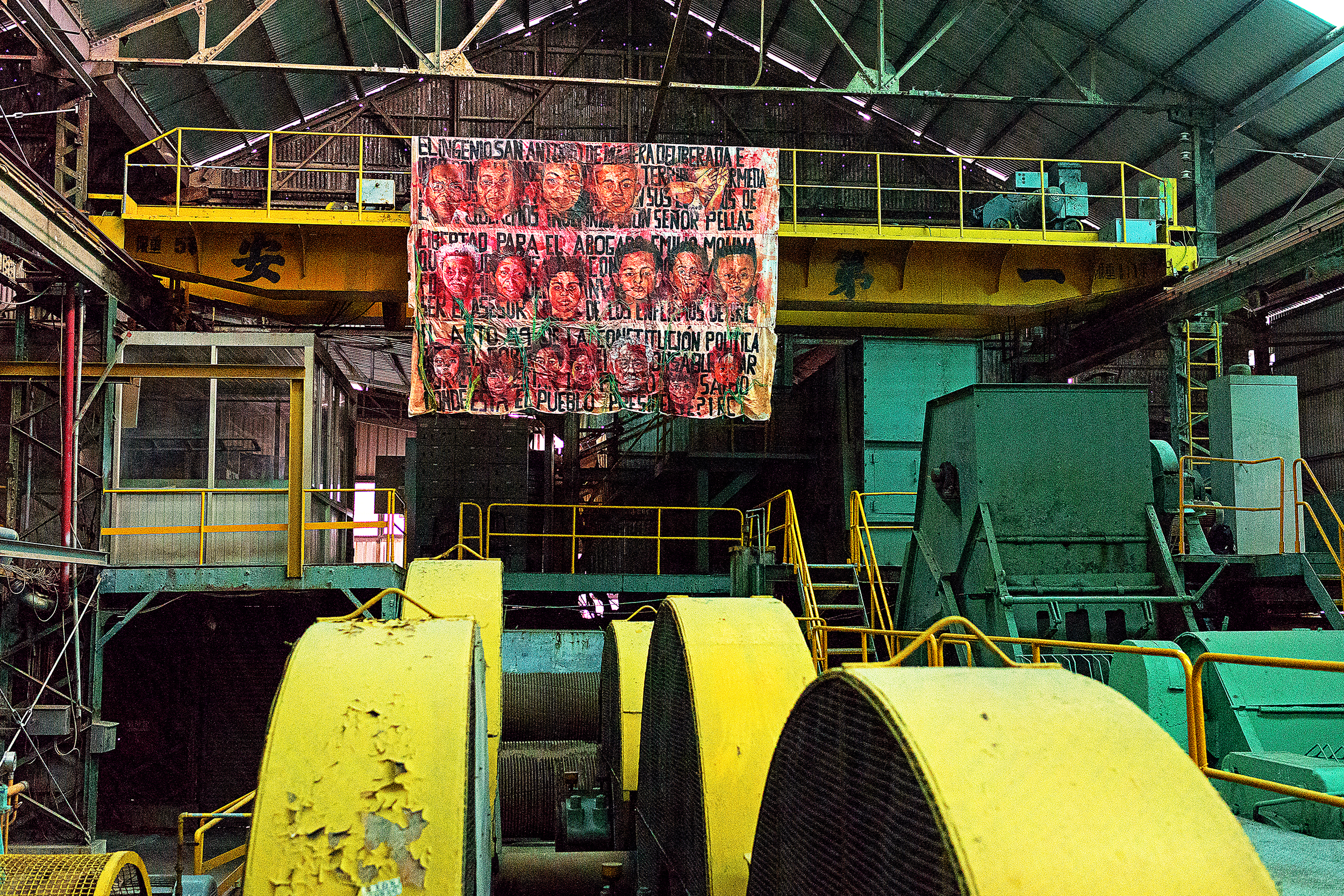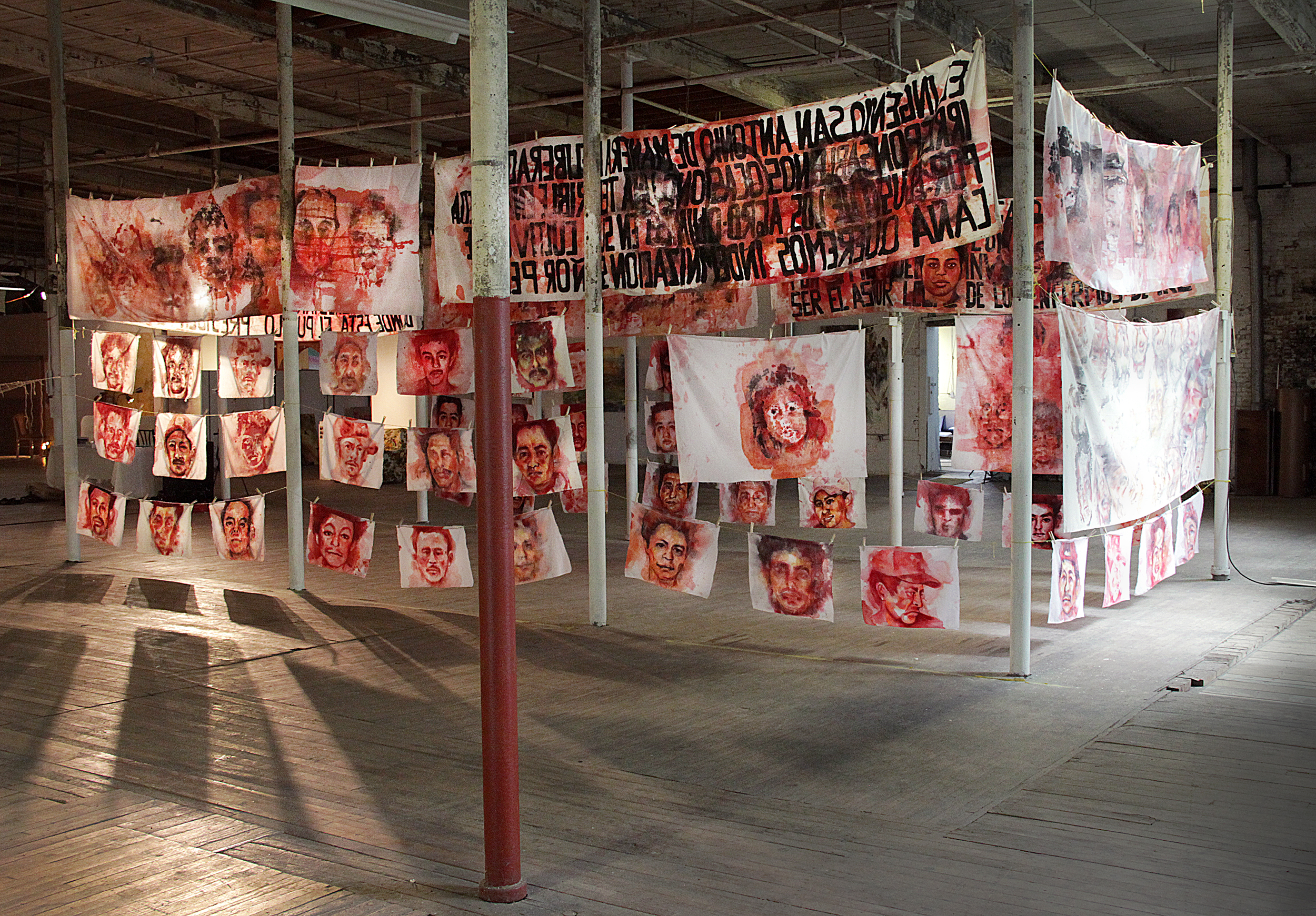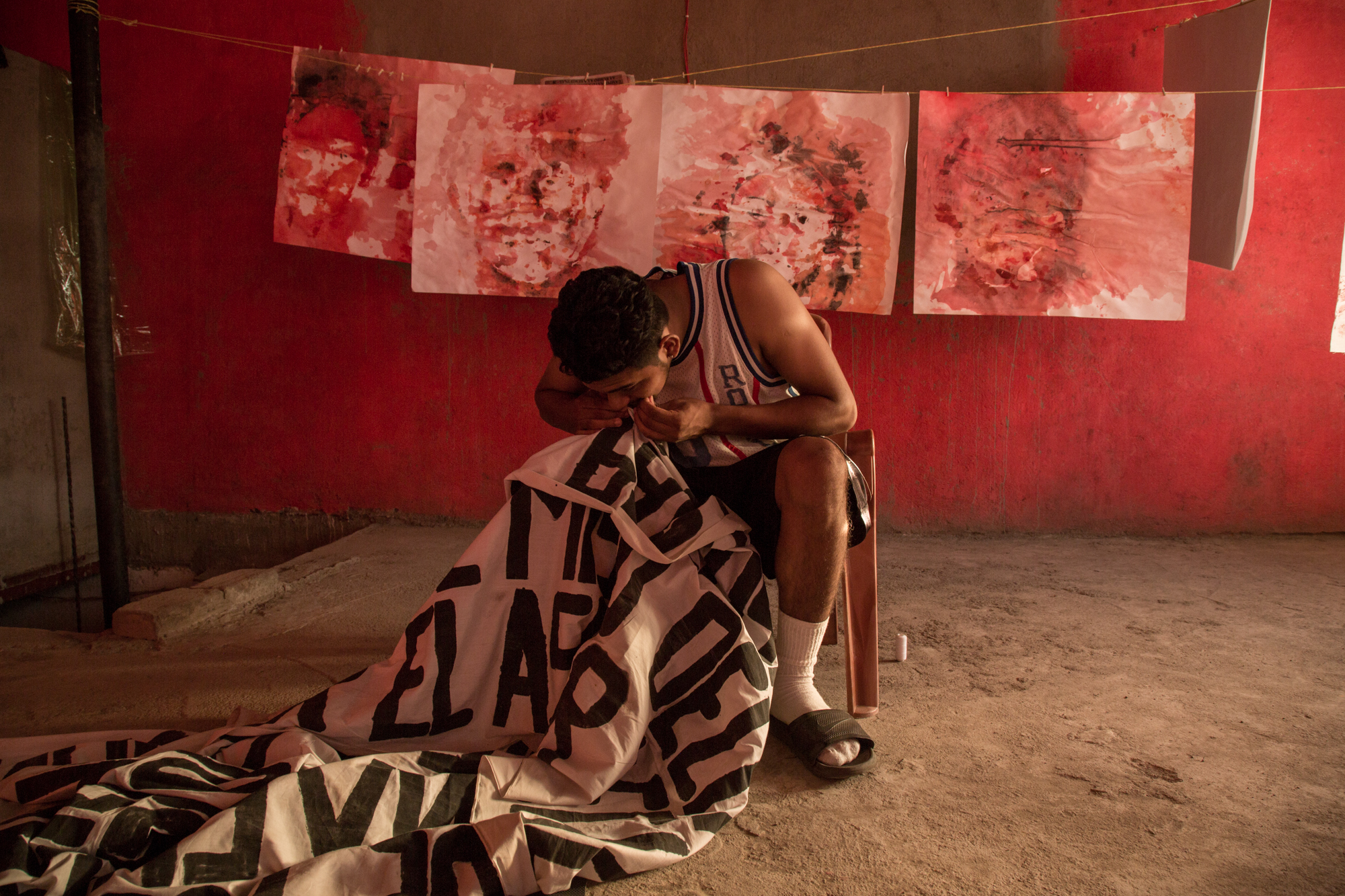
A film by Tom Laffay documenting the project 'Empalagoso: The Chichigalpa Portrait Project', a collaboration with Aubrey Roemer and Cristhian Velasquez. Additional camera assisted from Kevin Haminton and Magdiel Enrrique Castro. Additional production assistance by Bryan Maldonado and Cesar Dread. Special thanks to La Isla Network and World Connect for making this project possible.


Inside the framework of a church: 23 works on cloth with water based paint, marker, and epoxy resin, 30" x 24" each, in a gallery constructed from 50 industrial sugar bags sewn together with wooden posts. The portraits are sugarcane workers, who died of chronic kidney disease of unknown origins (CKDu), were exhibited in Chichigalpa, and given to family members to serve as a permanent memorial.

23 works on cloth with water based paint, marker, and epoxy resin, 30" x 24, 2016.
The portraits are of men, all sugarcane workers who died young of chronic kidney disease of unknown origins (CKDu), were exhibited in the community of La Cuitanca, Chichigalpa, Nicaragua, where 9,000 have passed away from this epidemic. After the exhibition, they were taken home by family members to serve as a permanent memorial of these fathers, brothers, sons and uncles.


Inside the framework of a church: 23 works on cloth with water based paint, marker, and epoxy resin, 30" x 24" each, in a gallery constructed from 50 industrial sugar bags sewn together with wooden posts. The portraits are sugarcane workers, who died of chronic kidney disease of unknown origins (CKDu), were exhibited in Chichigalpa, and given to family members to serve as a permanent memorial.

Inside the framework of a church: 23 works on cloth with water based paint, marker, and epoxy resin, 30" x 24" each, in a gallery constructed from 50 industrial sugar bags sewn together with wooden posts. The portraits are sugarcane workers, who died of chronic kidney disease of unknown origins (CKDu), were exhibited in Chichigalpa, and given to family members to serve as a permanent memorial.

Memorial portraits on cloth, marker, and paint installed on the infrastructure of a former sugar refinery at Taiwan Sugar Museum, for the exhibition 'Alchemy' K.A.T. Sugar Refinery Artist Village, 2015.

Memorial portraits on cloth, marker, and paint installed on the infrastructure of a former sugar refinery at Taiwan Sugar Museum, for the exhibition 'Alchemy' K.A.T. Sugar Refinery Artist Village, 2015.

Memorial portraits on cloth, marker, and paint installed on the infrastructure of a former sugar refinery at Taiwan Sugar Museum, for the exhibition 'Alchemy' K.A.T. Sugar Refinery Artist Village, 2015.

Memorial portraits on cloth, marker, and paint installed on the infrastructure of a former sugar refinery at Taiwan Sugar Museum, for the exhibition 'Alchemy' K.A.T. Sugar Refinery Artist Village, 2015.

Former protest banners, cloth, marker, and paint installed on the infrastructure of a former sugar refinery at Taiwan Sugar Museum, for the exhibition 'Alchemy' K.A.T. Sugar Refinery Artist Village, 2015.

Former protest banners, cloth, marker, and paint installed on the infrastructure of a former sugar refinery at Taiwan Sugar Museum, at K.A.T. Sugar Refinery Artist Village, 2015.

Former protest banners, cloth, marker, and paint installed on the infrastructure of a former sugar refinery at Taiwan Sugar Museum, for the exhibition 'Alchemy' K.A.T. Sugar Refinery Artist Village, 2015.

Former protest banners, cloth, marker, and paint installed on the infrastructure of a former sugar refinery at Taiwan Sugar Museum, for the exhibition 'Alchemy' K.A.T. Sugar Refinery Artist Village, 2015.

Former protest banners, cloth, marker, paint, rope, and clothespins, 40” x 18” x 18”, 2015. Exhibition of memorial portraits of deceased sugarcane workers, monoprints, and painted protest banners - the three components of this project arranged together at Garner Arts Center with Artshape Mammoth.

Former protest banners, cloth, marker, paint, rope, and clothespins, 40” x 18” x 18”, 2015. Exhibition of memorial portraits of deceased sugarcane workers, monoprints, and painted protest banners - the three components of this project arranged together at Garner Arts Center with Artshape Mammoth.

Former protest banners, cloth, marker, paint, rope, and clothespins, 40” x 18” x 18”, 2015. Exhibition of memorial portraits of deceased sugarcane workers, monoprints, and painted protest banners - the three components of this project arranged together at Garner Arts Center with Artshape Mammoth.

The banners were donated by the advocacy group ANAPIR, who had previously foot marched them 77 miles to Managua from Chichigalpa. Here, one is pictured with painted portraits in protest once again.

Former protest banners, cloth, marker, and paint installed on a freshly burnt sugarcane colono in Posoltega, Nicaragua, 2015.

Former protest banners, cloth, marker, and paint installed on a freshly burnt sugarcane colono in Posoltega, Nicaragua, 2015.

Former protest banners, cloth, marker, and paint being installed by activist and artist, Cristhian Velasquez, on a freshly burnt sugarcane colono in Posoltega, Nicaragua, 2015.

Former protest banners, cloth, marker, and paint installed on a freshly burnt sugarcane colono in Posoltega, Nicaragua, 2015.

Former protest banners, cloth, marker, paint, varying dimensions, 2015. The banners, memorial portraits, and mono-prints were installed in chemically treated cane fields, prior to the field being burned, a crucial component in the industrial harvesting of sugarcane.

Former protest banners, cloth, marker, paint, varying dimensions, 2015. The banners, memorial portraits, and mono-prints were installed in chemically treated cane fields, prior to the field being burned, a crucial component in the industrial harvesting of sugarcane.

Former protest banners, cloth, marker, paint, varying dimensions, 2015. The banners, memorial portraits, and mono-prints were installed in chemically treated cane fields, prior to the field being burned, a crucial component in the industrial harvesting of sugarcane.

Former protest banners, cloth, marker, paint, varying dimensions, 2015. The banners, memorial portraits, and mono-prints were installed in chemically treated cane fields, prior to the field being burned, a crucial component in the industrial harvesting of sugarcane.

Memorial portraits on cloth with marker and paint, varying dimensions, 2015. The portraits were installed in tall cane fields, after the green cane installation - the entire process followed the growth of the cane to harvest.

Memorial portraits on cloth with marker and paint, varying dimensions, 2015. The portraits were installed in tall cane fields, after the green cane installation - the entire process followed the growth of the cane to harvest. In this installation, we were joined by members of the surrounding community, who recognized some of the men painted and engaged in discussing the CKDu epidemic and work.

Memorial portraits on cloth with marker and paint, varying dimensions, 2015. The portraits were installed in tall cane fields, after the green cane installation - the entire process followed the growth of the cane to harvest. In this installation, we were joined by members of the surrounding community, who recognized some of the men painted and engaged in discussing the CKDu epidemic and work.

The banners were donated by the advocacy group ANAPIR, who had previously foot marched them 77 miles to Managua from Chichigalpa. Here, they are pictured with painted portraits in protest once again. 2015.

The banners were donated by the advocacy group ANAPIR, who had previously foot marched them 77 miles to Managua from Chichigalpa. Here, they are pictured with painted portraits in protest once again. 2015.

The banners were donated by the advocacy group ANAPIR, who had previously foot marched them 77 miles to Managua from Chichigalpa. Here, they are pictured with painted portraits in protest once again. 2015.

Former protest banners, cloth, marker, paint, varying dimensions, 2015. The banners and their mono-prints were installed in green cane fields, as the very first installation of the work, directly connecting it to the land.

Former protest banners, cloth, marker, paint, varying dimensions, 2015. The banners and their mono-prints were installed in green cane fields, as the very first installation of the work, directly connecting it to the land.

Former protest banners, cloth, marker, paint, varying dimensions, 2015. The banners and their mono-prints were installed in green cane fields, as the very first installation of the work, directly connecting it to the land.














































A film by Tom Laffay documenting the project 'Empalagoso: The Chichigalpa Portrait Project', a collaboration with Aubrey Roemer and Cristhian Velasquez. Additional camera assisted from Kevin Haminton and Magdiel Enrrique Castro. Additional production assistance by Bryan Maldonado and Cesar Dread. Special thanks to La Isla Network and World Connect for making this project possible.
Inside the framework of a church: 23 works on cloth with water based paint, marker, and epoxy resin, 30" x 24" each, in a gallery constructed from 50 industrial sugar bags sewn together with wooden posts. The portraits are sugarcane workers, who died of chronic kidney disease of unknown origins (CKDu), were exhibited in Chichigalpa, and given to family members to serve as a permanent memorial.
23 works on cloth with water based paint, marker, and epoxy resin, 30" x 24, 2016.
The portraits are of men, all sugarcane workers who died young of chronic kidney disease of unknown origins (CKDu), were exhibited in the community of La Cuitanca, Chichigalpa, Nicaragua, where 9,000 have passed away from this epidemic. After the exhibition, they were taken home by family members to serve as a permanent memorial of these fathers, brothers, sons and uncles.
Inside the framework of a church: 23 works on cloth with water based paint, marker, and epoxy resin, 30" x 24" each, in a gallery constructed from 50 industrial sugar bags sewn together with wooden posts. The portraits are sugarcane workers, who died of chronic kidney disease of unknown origins (CKDu), were exhibited in Chichigalpa, and given to family members to serve as a permanent memorial.
Inside the framework of a church: 23 works on cloth with water based paint, marker, and epoxy resin, 30" x 24" each, in a gallery constructed from 50 industrial sugar bags sewn together with wooden posts. The portraits are sugarcane workers, who died of chronic kidney disease of unknown origins (CKDu), were exhibited in Chichigalpa, and given to family members to serve as a permanent memorial.
Memorial portraits on cloth, marker, and paint installed on the infrastructure of a former sugar refinery at Taiwan Sugar Museum, for the exhibition 'Alchemy' K.A.T. Sugar Refinery Artist Village, 2015.
Memorial portraits on cloth, marker, and paint installed on the infrastructure of a former sugar refinery at Taiwan Sugar Museum, for the exhibition 'Alchemy' K.A.T. Sugar Refinery Artist Village, 2015.
Memorial portraits on cloth, marker, and paint installed on the infrastructure of a former sugar refinery at Taiwan Sugar Museum, for the exhibition 'Alchemy' K.A.T. Sugar Refinery Artist Village, 2015.
Memorial portraits on cloth, marker, and paint installed on the infrastructure of a former sugar refinery at Taiwan Sugar Museum, for the exhibition 'Alchemy' K.A.T. Sugar Refinery Artist Village, 2015.
Former protest banners, cloth, marker, and paint installed on the infrastructure of a former sugar refinery at Taiwan Sugar Museum, for the exhibition 'Alchemy' K.A.T. Sugar Refinery Artist Village, 2015.
Former protest banners, cloth, marker, and paint installed on the infrastructure of a former sugar refinery at Taiwan Sugar Museum, at K.A.T. Sugar Refinery Artist Village, 2015.
Former protest banners, cloth, marker, and paint installed on the infrastructure of a former sugar refinery at Taiwan Sugar Museum, for the exhibition 'Alchemy' K.A.T. Sugar Refinery Artist Village, 2015.
Former protest banners, cloth, marker, and paint installed on the infrastructure of a former sugar refinery at Taiwan Sugar Museum, for the exhibition 'Alchemy' K.A.T. Sugar Refinery Artist Village, 2015.
Former protest banners, cloth, marker, paint, rope, and clothespins, 40” x 18” x 18”, 2015. Exhibition of memorial portraits of deceased sugarcane workers, monoprints, and painted protest banners - the three components of this project arranged together at Garner Arts Center with Artshape Mammoth.
Former protest banners, cloth, marker, paint, rope, and clothespins, 40” x 18” x 18”, 2015. Exhibition of memorial portraits of deceased sugarcane workers, monoprints, and painted protest banners - the three components of this project arranged together at Garner Arts Center with Artshape Mammoth.
Former protest banners, cloth, marker, paint, rope, and clothespins, 40” x 18” x 18”, 2015. Exhibition of memorial portraits of deceased sugarcane workers, monoprints, and painted protest banners - the three components of this project arranged together at Garner Arts Center with Artshape Mammoth.
The banners were donated by the advocacy group ANAPIR, who had previously foot marched them 77 miles to Managua from Chichigalpa. Here, one is pictured with painted portraits in protest once again.
Former protest banners, cloth, marker, and paint installed on a freshly burnt sugarcane colono in Posoltega, Nicaragua, 2015.
Former protest banners, cloth, marker, and paint installed on a freshly burnt sugarcane colono in Posoltega, Nicaragua, 2015.
Former protest banners, cloth, marker, and paint being installed by activist and artist, Cristhian Velasquez, on a freshly burnt sugarcane colono in Posoltega, Nicaragua, 2015.
Former protest banners, cloth, marker, and paint installed on a freshly burnt sugarcane colono in Posoltega, Nicaragua, 2015.
Former protest banners, cloth, marker, paint, varying dimensions, 2015. The banners, memorial portraits, and mono-prints were installed in chemically treated cane fields, prior to the field being burned, a crucial component in the industrial harvesting of sugarcane.
Former protest banners, cloth, marker, paint, varying dimensions, 2015. The banners, memorial portraits, and mono-prints were installed in chemically treated cane fields, prior to the field being burned, a crucial component in the industrial harvesting of sugarcane.
Former protest banners, cloth, marker, paint, varying dimensions, 2015. The banners, memorial portraits, and mono-prints were installed in chemically treated cane fields, prior to the field being burned, a crucial component in the industrial harvesting of sugarcane.
Former protest banners, cloth, marker, paint, varying dimensions, 2015. The banners, memorial portraits, and mono-prints were installed in chemically treated cane fields, prior to the field being burned, a crucial component in the industrial harvesting of sugarcane.
Memorial portraits on cloth with marker and paint, varying dimensions, 2015. The portraits were installed in tall cane fields, after the green cane installation - the entire process followed the growth of the cane to harvest.
Memorial portraits on cloth with marker and paint, varying dimensions, 2015. The portraits were installed in tall cane fields, after the green cane installation - the entire process followed the growth of the cane to harvest. In this installation, we were joined by members of the surrounding community, who recognized some of the men painted and engaged in discussing the CKDu epidemic and work.
Memorial portraits on cloth with marker and paint, varying dimensions, 2015. The portraits were installed in tall cane fields, after the green cane installation - the entire process followed the growth of the cane to harvest. In this installation, we were joined by members of the surrounding community, who recognized some of the men painted and engaged in discussing the CKDu epidemic and work.
The banners were donated by the advocacy group ANAPIR, who had previously foot marched them 77 miles to Managua from Chichigalpa. Here, they are pictured with painted portraits in protest once again. 2015.
The banners were donated by the advocacy group ANAPIR, who had previously foot marched them 77 miles to Managua from Chichigalpa. Here, they are pictured with painted portraits in protest once again. 2015.
The banners were donated by the advocacy group ANAPIR, who had previously foot marched them 77 miles to Managua from Chichigalpa. Here, they are pictured with painted portraits in protest once again. 2015.
Former protest banners, cloth, marker, paint, varying dimensions, 2015. The banners and their mono-prints were installed in green cane fields, as the very first installation of the work, directly connecting it to the land.
Former protest banners, cloth, marker, paint, varying dimensions, 2015. The banners and their mono-prints were installed in green cane fields, as the very first installation of the work, directly connecting it to the land.
Former protest banners, cloth, marker, paint, varying dimensions, 2015. The banners and their mono-prints were installed in green cane fields, as the very first installation of the work, directly connecting it to the land.